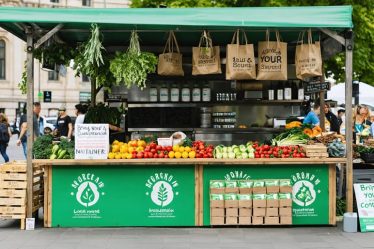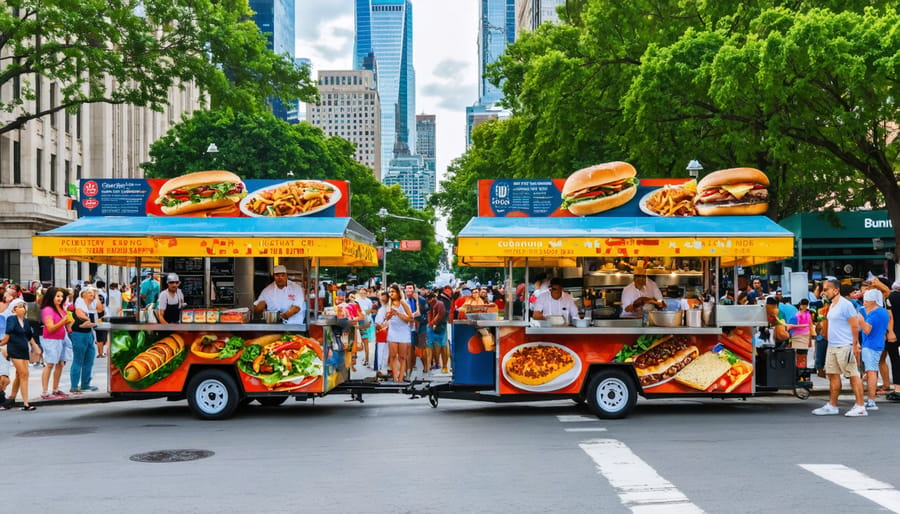
Step onto any bustling street corner in America, and you’ll discover a vibrant tapestry of flavors that tells the story of our nation’s cultural significance of food traditions. From the steaming hot dog carts of New York City to the colorful taco trucks of Los Angeles, street food in the United States is more than just quick, convenient fare – it’s a delicious reflection of our diverse heritage and regional identity.
Each city’s street food scene serves as a living museum of local history, where immigrant influences blend seamlessly with American innovation. In New Orleans, po’ boys tell tales of labor strikes and Creole culture, while Philadelphia’s cheesesteaks embody the city’s working-class spirit. Portland’s food cart pods showcase the Pacific Northwest’s commitment to sustainability and culinary experimentation, while Miami’s Cuban food windows preserve generations of family recipes and community traditions.
These humble street-side establishments don’t just feed our hunger – they nourish our understanding of America’s ever-evolving culinary landscape. Whether it’s a late-night slice in Manhattan or a breakfast burrito in San Francisco, every bite carries the essence of the communities that created them.
The Northeast’s Street Food Revolution
New York’s Hot Dog Culture
There’s something magical about the sizzling aroma of hot dogs wafting through Manhattan’s busy streets. As a native New Yorker, I can tell you that our hot dog carts are more than just quick food stops – they’re cherished landmarks that have been feeding hungry locals and tourists alike for generations. These humble street-side vendors are among the city’s most beloved purveyors of iconic regional flavors.
Dating back to the 1860s, when German immigrants first introduced frankfurters to the city, hot dog carts have become an integral part of New York’s identity. The classic NYC hot dog – topped with spicy brown mustard, sauerkraut, and onion sauce – tells a story of immigrant influence and urban innovation. What started as a simple way for newcomers to make a living has evolved into a celebrated cultural institution.
You’ll find these carts everywhere from Central Park to Times Square, each with its own loyal following. Some vendors have been operating from the same corner for decades, becoming neighborhood fixtures where locals grab their daily lunch and share the latest community news. The affordability of street hot dogs (still around $3-4 in most places) makes them a democratic food that brings together people from all walks of life.
Whether you’re catching a quick bite before a Broadway show or satisfying late-night cravings after a night out, these hot dog carts serve up a taste of authentic New York that can’t be replicated anywhere else.
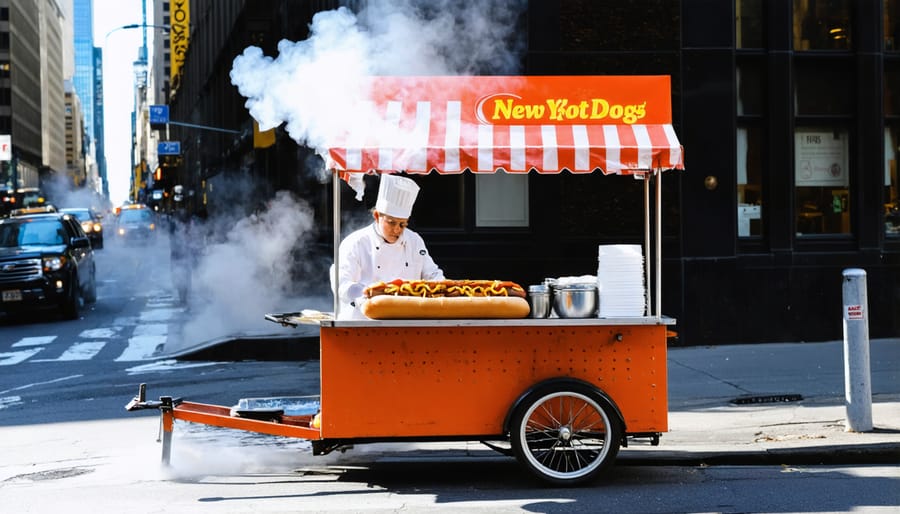
Philadelphia’s Cheesesteak Story
Picture this: It’s 1930s South Philadelphia, where the mouthwatering aroma of sizzling beef and onions wafts through the streets. Pat and Harry Olivieri, two hot dog vendors, decided to shake things up one day by grilling some thinly sliced beef on their flat-top grill. Little did they know they were about to create a culinary icon that would define their city.
The story goes that a passing cab driver, drawn in by the irresistible smell, asked to try their creation. Word spread like wildfire, and soon the brothers’ simple beef sandwich evolved into what we now know as the Philly cheesesteak. The addition of cheese came later – some say it was Cheese Whiz, others swear by provolone – but regardless, it was magic.
Pat’s King of Steaks, which opened in 1940, became the first dedicated cheesesteak joint, followed by the friendly rivalry with Geno’s Steaks across the street. What started as humble street food became a cultural phenomenon that drew visitors from around the world. Today, ordering a cheesesteak in Philly is practically a rite of passage, complete with its own language: “wit” or “witout” onions, and don’t forget to specify your cheese preference!
The cheesesteak transcended its street food origins to become a symbol of Philadelphia’s working-class roots and innovative spirit. It’s proof that sometimes the simplest ideas, born on the streets, can become legendary.
Southern Street Food Heritage
New Orleans’ Food Cart Legacy
New Orleans’ street food scene perfectly embodies the city’s soul, where generations of vendors have transformed simple carts into cultural landmarks. Among the city’s diverse culinary landscapes, few experiences match the joy of biting into a perfectly dressed po’boy from a neighborhood cart, where crusty French bread meets succulent seafood or roast beef “debris.”
The aroma of fresh beignets wafting through the French Quarter has been a morning ritual since the 19th century, with mobile vendors serving these powdered sugar-dusted pillows of happiness alongside café au lait. Today’s food carts continue this sweet tradition, though you’ll find them beyond just Café du Monde.
Lucky Dogs, with their iconic hot dog carts, have been a late-night French Quarter fixture since the 1950s, offering sustenance to revelers and locals alike. These cheerful vendors, with their illuminated carts and friendly banter, are as much a part of Bourbon Street’s character as the jazz clubs themselves.
The modern NOLA street food scene has evolved to include Creole and Cajun classics like jambalaya and red beans and rice, served from sleek food trucks. Yet it’s the traditional cart vendors who’ve preserved the authentic flavors and warming hospitality that make New Orleans’ street food culture truly special.
Miami’s Cuban Street Food Scene
The vibrant streets of Miami’s Little Havana neighborhood tell a story of cultural heritage through the irresistible aromas of Cuban street food. Walking down Calle Ocho, you’ll find yourself transported to Havana’s bustling thoroughfares, where food vendors serve up authentic Cuban flavors that have become an integral part of Florida’s culinary identity.
At the heart of Miami’s Cuban street food scene is the iconic Cuban sandwich, a perfect marriage of ham, roasted pork, Swiss cheese, pickles, and mustard, pressed between crispy Cuban bread. But venture a little deeper, and you’ll discover so much more. Food windows (ventanitas) dot the neighborhood, serving colada coffee in tiny cups meant for sharing – a beautiful representation of the community’s social fabric.
Local favorites include croquetas, crispy rolled delights filled with ham or chicken, perfect for an afternoon snack. The smell of freshly fried empanadas, stuffed with picadillo (seasoned ground beef) or guava and cheese, wafts through the air. For something sweet, churros filled with dulce de leche have become a beloved street treat, while pan de gloria (sweet bread) offers a taste of morning tradition.
What makes Miami’s Cuban street food scene truly special isn’t just the food – it’s the way these culinary traditions have preserved cultural connections while creating new fusion experiences that reflect modern Miami’s dynamic spirit. Whether you’re grabbing a quick breakfast of tostada and café con leche or enjoying a late-night pan con bistec, you’re participating in a living cultural exchange that’s been simmering for over half a century.
West Coast Street Food Innovation
LA’s Taco Truck Revolution
Los Angeles’ love affair with taco trucks has revolutionized not just California’s culinary scene, but the entire American street food landscape. What started as humble loncheras serving late-night workers has blossomed into a vibrant movement that perfectly captures LA’s multicultural spirit and entrepreneurial energy.
The real game-changer came in 2008 when Roy Choi’s Kogi BBQ truck merged Korean and Mexican flavors, creating an instant sensation that sparked what we now recognize as one of the most influential modern food innovation trends. Soon, the streets of LA were dotted with trucks serving everything from gourmet grilled cheese to fusion sushi burritos.
What makes LA’s taco truck scene truly special is its accessibility and authenticity. Whether you’re craving al pastor at 2 AM in Echo Park or fish tacos in Venice Beach at sunset, there’s always a truck nearby serving up fresh, affordable, and incredibly delicious food. These mobile kitchens have become neighborhood landmarks, creating community gathering spots where people from all walks of life come together over perfectly charred tortillas and homemade salsas.
The movement has inspired countless entrepreneurs to take their culinary dreams to the streets, proving that great food doesn’t need a fancy brick-and-mortar location to thrive. Today, LA’s taco trucks represent more than just convenient dining – they’re a testament to the city’s innovative spirit and cultural diversity.
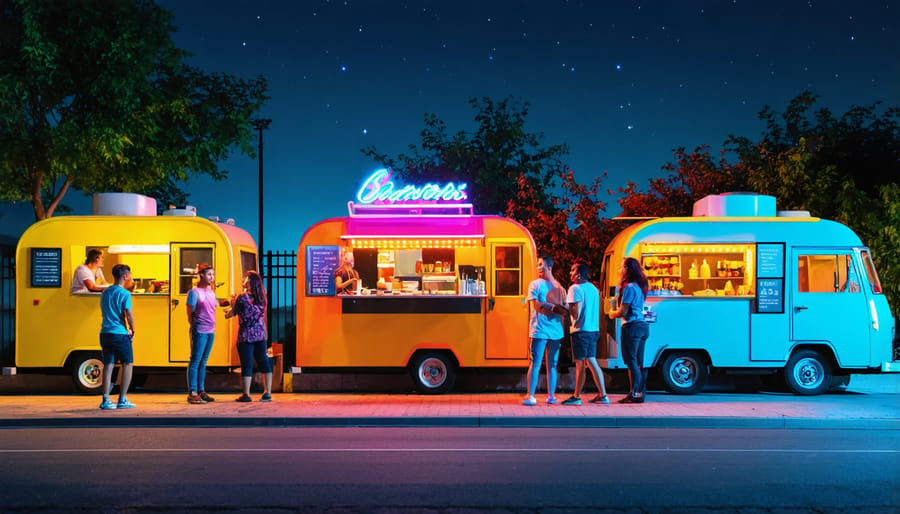
Portland’s Food Cart Culture
Portland’s vibrant food cart scene has revolutionized how we think about street food in America. What started as a few humble carts has blossomed into a citywide phenomenon, with over 500 food carts clustered in “pods” throughout the city. These pods have become beloved community gathering spots where locals and tourists alike can sample everything from Korean-Mexican fusion tacos to artisanal grilled cheese sandwiches.
Unlike traditional food trucks, Portland’s carts typically stay in one location, allowing owners to build loyal customer bases and experiment with creative cuisine. The city’s flexible regulations and lower startup costs have made it possible for aspiring chefs to test their concepts without the overhead of a brick-and-mortar restaurant.
I remember my first visit to the Alder Street pod (now relocated), where the overwhelming array of options – from Thai curry to wood-fired pizza – had me circling the block three times before making a decision. That’s the beauty of Portland’s cart culture: you can travel the world in just one block.
These pods have become more than just places to grab a quick bite. With covered seating areas, beer gardens, and even live music, they’re social hubs where Portland’s famous quirky culture truly shines. Local favorites like Nong’s Khao Man Gai have even grown from humble cart beginnings into successful restaurants, proving that sometimes the best culinary innovations start on the street.
Midwest Street Food Traditions
Chicago’s Street Food Legacy
When I think of Chicago’s street food story, Maxwell Street Market instantly comes to mind. This bustling marketplace has been the beating heart of the city’s street food scene since the late 1800s, where the famous Maxwell Street Polish sausage first made its mark on Chicago’s culinary landscape.
Walking through Maxwell Street today feels like stepping into a living history book. The aroma of grilled onions and sizzling meat still wafts through the air, just as it did when immigrant vendors first set up their stands over a century ago. The Polish sausage stands, with their perfectly charred dogs topped with mustard and those signature grilled onions, have become such an integral part of Chicago’s identity that you’ll find them dotting street corners throughout the city.
But Chicago’s street food scene has evolved far beyond its Polish sausage roots. Today’s food festivals showcase everything from elotes (Mexican street corn) to pierogi food trucks, reflecting the city’s rich immigrant heritage. The Taste of Chicago, which started as a small food festival in 1980, has grown into one of the world’s largest food festivals, drawing millions of visitors annually.
What makes Chicago’s street food special is how it continues to honor its historical roots while embracing new flavors and traditions. Whether you’re grabbing a quick lunch from a tamale cart or exploring the modern Maxwell Street Market’s diverse offerings, you’re experiencing a delicious piece of Chicago’s ever-evolving cultural tapestry.
State Fair Food Culture
Step into the whimsical world of state fair food, where culinary creativity knows no bounds and deep-fried dreams come true. Every summer, across the Midwest’s sprawling fairgrounds, innovative food vendors compete to create the most talked-about treats, turning traditional comfort foods into spectacular novelties.
I’ll never forget my first bite of a deep-fried butter ball at the Iowa State Fair – a moment that perfectly captures the delightful absurdity of fair food culture. From Minnesota’s iconic cheese curds to Indiana’s sausage and peppers on a stick, each state adds its own spin to the fair food legacy.
These annual celebrations have become testing grounds for outrageous culinary experiments. Think chocolate-covered bacon, deep-fried candy bars, and pizzas served on a stick. The Texas State Fair, home of the famous Fletcher’s Corny Dogs since 1942, showcases how a simple idea can become a beloved tradition that sells millions.
What makes state fair food truly special is its ability to bring people together. Families gather around picnic tables sharing massive turkey legs, while friends dare each other to try the latest deep-fried creation. It’s a uniquely American experience where breaking the rules of conventional cooking isn’t just accepted – it’s celebrated.
These fairs have become annual pilgrimages for food lovers, where the only limit is the imagination of creative vendors who continue to push the boundaries of what can be battered, fried, or served on a stick.
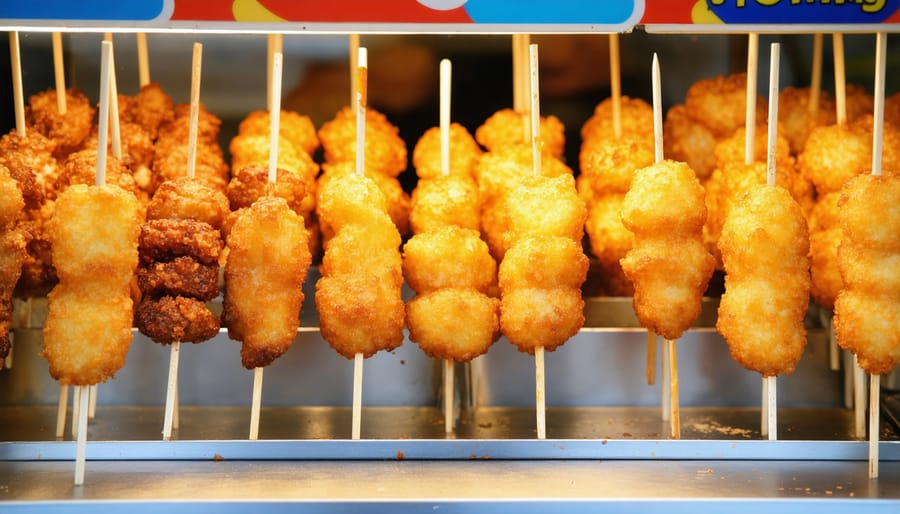
As I stroll through the vibrant streets of any American city today, I’m reminded of how street food continues to weave the diverse threads of our national identity into a delicious, ever-evolving tapestry. From the food trucks lining Portland’s artsy neighborhoods to the hot dog carts that have become synonymous with New York City’s hustle, street food remains a powerful reflection of who we are as Americans.
What makes American street food truly special is its ability to both preserve tradition and embrace innovation. In cities across the country, third-generation tamale vendors share sidewalk space with creative entrepreneurs serving Korean-Mexican fusion tacos, telling the ongoing story of American immigration and adaptation through their menus.
The rise of social media and food tourism has transformed many humble street foods into cultural icons, with people traveling across states just to try a famous cheesesteak in Philadelphia or a particular food truck’s signature dish in Austin. Yet at their heart, these foods remain deeply connected to their communities, serving as daily gathering points where locals connect and visitors get a true taste of place.
Looking ahead, American street food culture shows no signs of slowing down. Instead, it continues to evolve, reflecting our changing demographics, environmental consciousness, and desire for authentic experiences. Whether it’s traditional favorites or innovative new creations, street food remains one of the most democratic and accessible ways to experience America’s rich culinary heritage and its exciting future.

